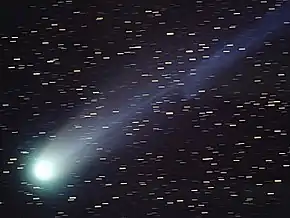C/2012 S4
C/2012 S4 (PANSTARRS) is a non-periodic comet with the largest listed aphelion of any object on the JPL Small-Body Database. But the listed aphelion distance of 500,000 AU (8 ly) from the Sun[1] is a generic near-perihelion unperturbed two-body solution that assumes the Sun and comet are the only two objects in the Universe. Other comets, such as C/2015 TQ209 (LINEAR) and C/2017 A3 (Elenin) have had epoch-dependent solutions with aphelia of more than 1,000,000 AU (16 ly).[2][3] As a comparison, the closest star, Proxima Centauri, is about 4.24 light years from the Sun, and Wolf 359 is 7.78 light years away. Any comet more than about 150,000 AU (2 ly) from the Sun can be considered lost to the interstellar medium. Using an epoch when C/2012 S4 (PANSTARRS) is beyond the planetary region of the Solar System, it is clear C/2012 S4 (PANSTARRS) will not be ejected from the Solar System.
| Discovery | |
|---|---|
| Discovered by | Pan-STARRS (Bryce Bolin, Peter Veres, Larry Denneau, Richard Wainscoat, Rob Jedicke, Marco Micheli) |
| Discovery date | 28 September 2012 |
| Orbital characteristics [ A] | |
| Epoch | 2013 April 22 (JD 2456404.5)[1] |
| Observation arc | 460 days[1] |
| Number of observations | 925[1] |
| Aphelion | ~5700 AU (barycentric)[lower-alpha 1] 504000±194000 AU[1] |
| Perihelion | 4.348730±0.000004 AU[1] |
| Semi-major axis | ~2800 AU (barycentric)[lower-alpha 1] 252000±97000 AU[1] |
| Eccentricity | 0.999983±0.000007[1] |
| Orbital period | ~150000 yr[lower-alpha 1] nonperiodic; est. (127±73)×106 yrs[1] |
| Inclination | 126.5413 degrees[1] |
| TJupiter | −1.540 |
| Comet total magnitude (M1) | 9.2 |
| Comet nuclear magnitude (M2) | 11.9 |
| Last perihelion | 2013 June 28 |
The maximum extent of the region in which the Sun's gravitational field is dominant, the Hill sphere, may extend to 230,000 astronomical units (3.6 light-years) as calculated in the 1960s.[4]
Neso (the outermost moon of Neptune) takes 27 years to orbit Neptune, comets can take up to 30 million years to orbit the Sun, and the Sun orbits the Milky Way in about 230 million years (a galactic year).
| Satellite | Orbital period (years) |
Parent body | Percentage of parent body orbital period |
|---|---|---|---|
| Sinope | 2.13 | Jupiter | 18% |
| S/2004 S 26 | 4.45 | Saturn | 15% |
| Ferdinand | 7.90 | Uranus | 9% |
| Neso | 26.7 | Neptune | 16% |
| Oort cloud comet | 30 million | Sun | 13% |
| Sun | 230 million | Milky Way | N/A |
Barycentric orbit
Integrating the orbit until the comet is outside the perturbations of the planets generates a barycentric aphelion of ~5700 AU and an orbital period of roughly 150,000 years.[5][lower-alpha 1] It will not be 30 AU from the Sun until 2028.
It is estimated to be approximately the same size as 67P/Churyumov–Gerasimenko.
See also
- List of Solar System objects by greatest aphelion
- List of non-periodic comets
- C/2019 Q4 (Borisov) (first interstellar comet, 2019 discovery)
Notes
- Given the orbital eccentricity of this object, different epochs can generate quite different heliocentric unperturbed two-body best-fit solutions to the semi-major axis and orbital period. For objects at such high eccentricity, the Solar System's barycenter is more stable than instantaneous heliocentric solutions that are influenced by the 12-year orbit of Jupiter. Using JPL Horizons, the barycentric aphelion is approximately 5700 AU with an orbital period of about 150000 years.[5]
References
- Comet C/2012 S4 (PANSTARRS) at the JPL Small Body Database
- Archive of C/2015 TQ209 (LINEAR) JPL 4 (epoch 2015-Oct-23) observation arc of 24 days
- Archive of C/2017 A3 (Elenin) JPL 3 (epoch 2017-Jan-08) observation arc of 12 days
- Chebotarev, G.A. (1964), "Gravitational Spheres of the Major Planets, Moon and Sun", Soviet Astronomy, 7 (5): 618–622, Bibcode:1964SvA.....7..618C
- Horizons output. "Barycentric Osculating Orbital Elements for Comet C/2012 S4 (PANSTARRS)". Retrieved 2015-09-26. (Solution using the Solar System Barycenter and barycentric coordinates. Select Ephemeris Type:Elements and Center:@0)




